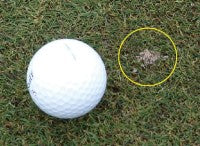Have you seen this earthworm?
Dr David T. Jones, earthworm specialist, Natural History Museum, London, and Dr Kate Entwistle, Turfgrass Pathologist, The Turf Disease Centre, Hampshire, need your help
 In the last five years a small, non-native earthworm called Microscolex phosphoreus has started appearing in golf greens and bowling greens across Britain. Isolated populations have been reported from Cornwall and Kent in the south, up to North Yorkshire. Unconfirmed sightings by turf mangers and agronomists suggest it may be spreading across the country, and your help is needed to investigate its distribution.
In the last five years a small, non-native earthworm called Microscolex phosphoreus has started appearing in golf greens and bowling greens across Britain. Isolated populations have been reported from Cornwall and Kent in the south, up to North Yorkshire. Unconfirmed sightings by turf mangers and agronomists suggest it may be spreading across the country, and your help is needed to investigate its distribution.
Microscolex phosphoreus is a small, pale worm of length 10-35 mm, and width 1.0-1.5 mm. It produces small casts on the surface that are about 10-15 mm in diameter, up to 10 mm in height, and can interfere with play. The casts are sometimes clustered close together indicating highly localised patches of infestation. It has been reported that this species cast throughout the day, causing a continuous problem, especially on putting greens.
No studies have been carried out on Microscolex phosphoreus in Britain but discussions with some turf managers whose greens are infested suggest that products used to reduce the surface casting of native earthworms have no affect on this invasive species, even when applied at the highest recommended concentrations. At the moment it is not subject to any official notification, nor is it on the list of quarantine species.
How you can help
The Natural History Museum and the Turf Disease Centre, sponsored by Syngenta Golf and Landscape, are investigating Microscolex phosphoreus to map its current distribution and to assess how rapidly it may be spreading. You can help by looking out for this species and its small casts on your golf greens and bowling greens. If you think you have this species, we would be very grateful if you would send us a small sample of infested turf.
 If possible, please use a golf hole changer to take the turf sample. Place the hole changer over a piece of turf with one or more casts on the surface. Remove the soil core and, with a sharp knife, cut the soil core at a depth of 50 -60mm and send us that top layer with the grass and roots still intact. If you don't have a golf hole changer, send a turf sample of similar surface area to a golf hole.
If possible, please use a golf hole changer to take the turf sample. Place the hole changer over a piece of turf with one or more casts on the surface. Remove the soil core and, with a sharp knife, cut the soil core at a depth of 50 -60mm and send us that top layer with the grass and roots still intact. If you don't have a golf hole changer, send a turf sample of similar surface area to a golf hole.
Please fill in the short questionnaire and return it with your sample. If you send your email address we will confirm whether or not you have Microscolex phosphoreus. All the information you send will only be seen and utilised by the Natural History Museum and The Turf Disease Centre, and will be treated as confidential. We will not disclose specific site locations or contact information to third parties.
A summary of our findings will be published in the Pitchcare magazine and website, and full results will be published in a soil science journal and made available on the web. In all publications, the distribution map of Microscolex phosphoreus will be plotted at low resolution to ensure precise locations cannot be determined.
Please click on the pdf to see questionnaire

